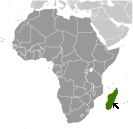World Atlas: Madagascar. On this page you can see the map, country flag and many detailed information about the people, history and economy of Madagascar.

Here you can find online selected information about the geography, inhabitants, government, economy and history of Madagascar. Included are selected statistics, an overview map and the detailed map of Madagascar. But let's start with the flag of Madagascar here:
Madagascar - Overview:
What you should know about Madagascar? Let's start with this: Madagascar was one of the last major landmasses on earth to be colonized by humans. The earliest settlers from present-day Indonesia arrived between A.D. 350 and 550. The island attracted Arab and Persian traders as early as the 7th century, and migrants from Africa arrived around A.D. 1000. Madagascar was a pirate stronghold during the late 17th and early 18th centuries, and served as a slave trading center into the 19th century. From the 16th to the late 19th century, a native Merina Kingdom dominated much of Madagascar. The island was conquered by the French in 1896 who made it a colony; independence was regained in 1960. During 1992-93, free presidential and National Assembly elections were held ending 17 years of single-party rule. In 1997, in the second presidential race, Didier Ratsiraka, the leader during the 1970s and 1980s, was returned to the presidency. The 2001 presidential election was contested between the followers of Didier Ratsiraka and Marc Ravalomanana, nearly causing secession of half of the country. In April 2002, the High Constitutional Court announced Ravalomanana the winner. Ravalomanana won a second term in 2006 but, following protests in 2009, handed over power to the military, which then conferred the presidency on the mayor of Antananarivo, Andry Rajoelina, in what amounted to a coup d'etat. Following a lengthy mediation process led by the Southern African Development Community, Madagascar held UN-supported presidential and parliamentary elections in 2013. Former de facto finance minister Hery Rajaonarimampianina won a runoff election in December 2013 and was inaugurated in January 2014.
Geography of Madagascar
 Where on the globe is Madagascar? The location of this country is Southern Africa, island in the Indian Ocean, east of Mozambique. Total area of Madagascar is 587,041 sq km, of which 581,540 sq km is land. So this is quite a large country. How could we describe the terrain of the country? This way: narrow coastal plain, high plateau and mountains in cente. The lowest point of Madagascar is Indian Ocean 0 m, the highest point Maromokotro 2,876 m. And the climate is tropical along coast, temperate inland, arid in south.
Where on the globe is Madagascar? The location of this country is Southern Africa, island in the Indian Ocean, east of Mozambique. Total area of Madagascar is 587,041 sq km, of which 581,540 sq km is land. So this is quite a large country. How could we describe the terrain of the country? This way: narrow coastal plain, high plateau and mountains in cente. The lowest point of Madagascar is Indian Ocean 0 m, the highest point Maromokotro 2,876 m. And the climate is tropical along coast, temperate inland, arid in south.
Inhabitants of Madagascar
Let's take a look how many people live in Madagascar. The number is: 25,054,161 (July 2017 est.). So quite a lot people live here. Who lives here? Malayo-Indonesian (Merina and related Betsileo), Cotiers (mixed African, Malayo-Indonesian, and Arab ancestry - Betsimisaraka, Tsimihety, Antaisaka, Sakalava), French, Indian, Creole, Comoran. What are the languages in Madagascar? French (official), Malagasy (official), English. And the religions: Christian, indigenous religionist, Muslim. How old are the people in average? 19.7 years. We have to add that this number is the median - so one half of the people is older than this, one half is younger. And what is their life expectancy (at birth)? This: 66.3 years. Where the people live in Madagascar? Here: most of population lives on the eastern half of the island; significant clustering is found in the central highlands and eastern coastline. The major urban areas of Madagascar are: Antananarivo (capital) 2.61 million (2015).
Government and Economy of Madagascar
The capital of Madagascar is Antananarivo and the government type semi-presidential republic. Let's take a look at the administrative divisions - 6 provinces (faritany); Antananarivo, Antsiranana, Fianarantsoa, Mahajanga, Toamasina, Toliara. Regarding the economy of Madagascar, important industrial products are meat processing, seafood, soap, beer, leather, sugar, textiles, glassware, cement, automobile assembly plant, paper, petroleum, tourism, mining. Important agricultural products are coffee, vanilla, sugarcane, cloves, cocoa, rice, cassava (manioc, tapioca), beans, bananas, peanuts; livestock products. The most important export commodities are coffee, vanilla, shellfish, sugar, cotton cloth, clothing, chromite, petroleum products and the most important export partners are France 23.5%, US 12.8%, Germany 8.3%, China 6.3%, Japan 5%, Netherlands 4.3%, South Korea 4.2% (2016). The most important import commodities are capital goods, petroleum, consumer goods, food and the most important import partners are China 21.2%, France 6.9%, India 6.5%, UAE 5.6%, Saudi Arabia 5%, South Africa 5% (2016). How rich is Madagascar and how rich are people in this country? The most important number here is GDP per capita (PPP): $1,600 (2017 est.). This is a very low number. Let's add that this means Gross Domestic Product per person, which is recalculated with respect to the relative cost of local goods and services. And one more important number - population below poverty line: 70.7% (2012 est.).